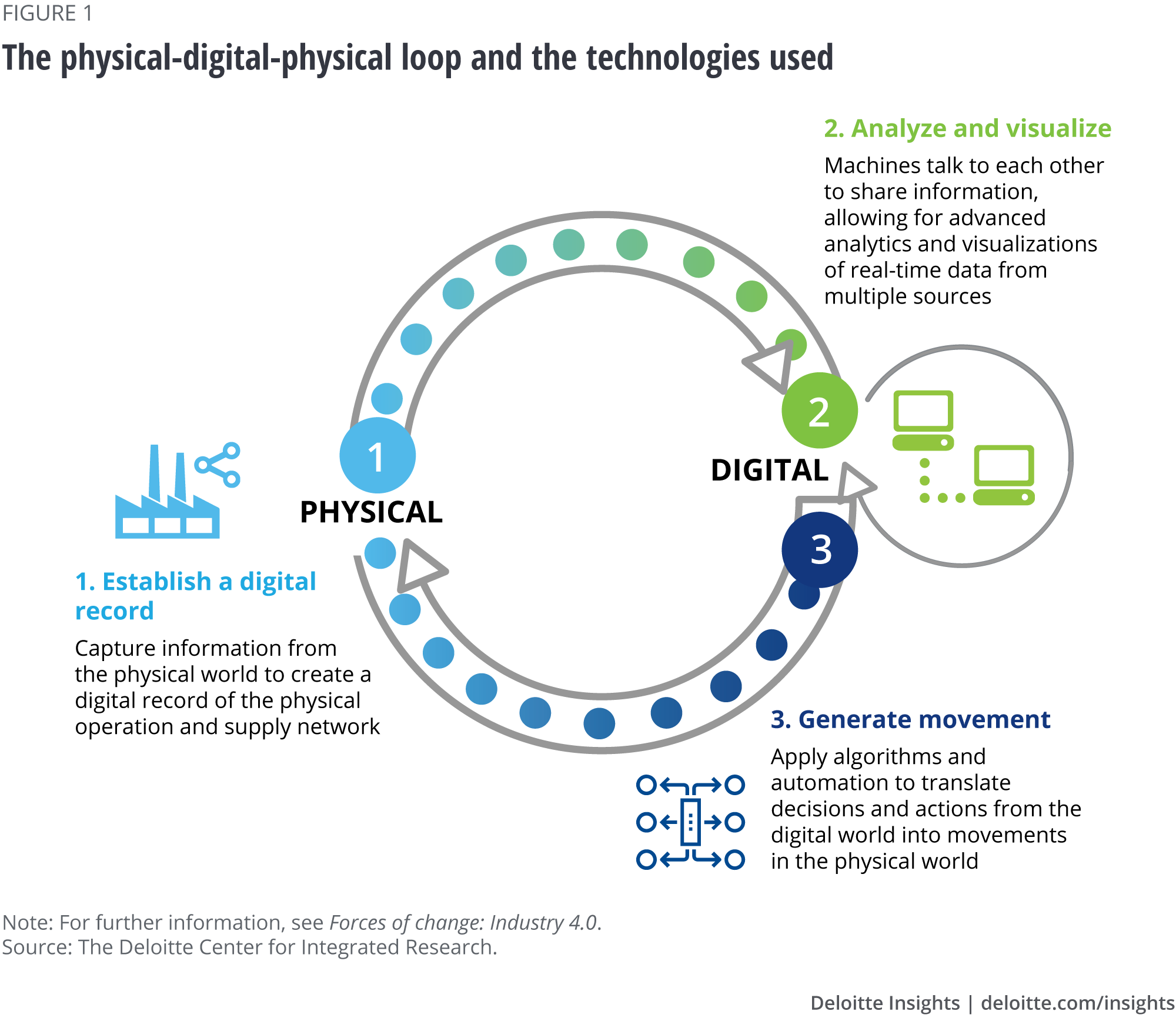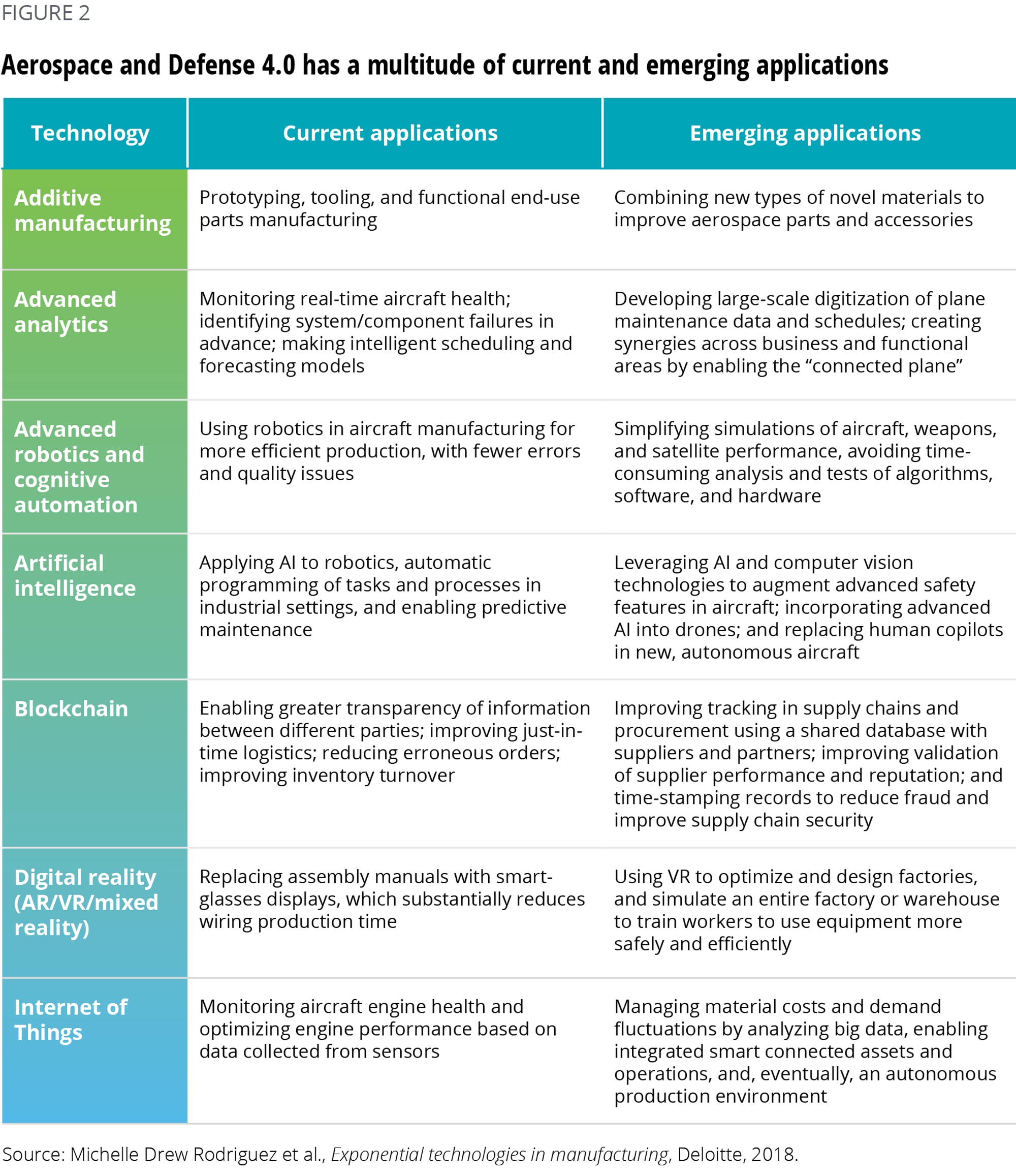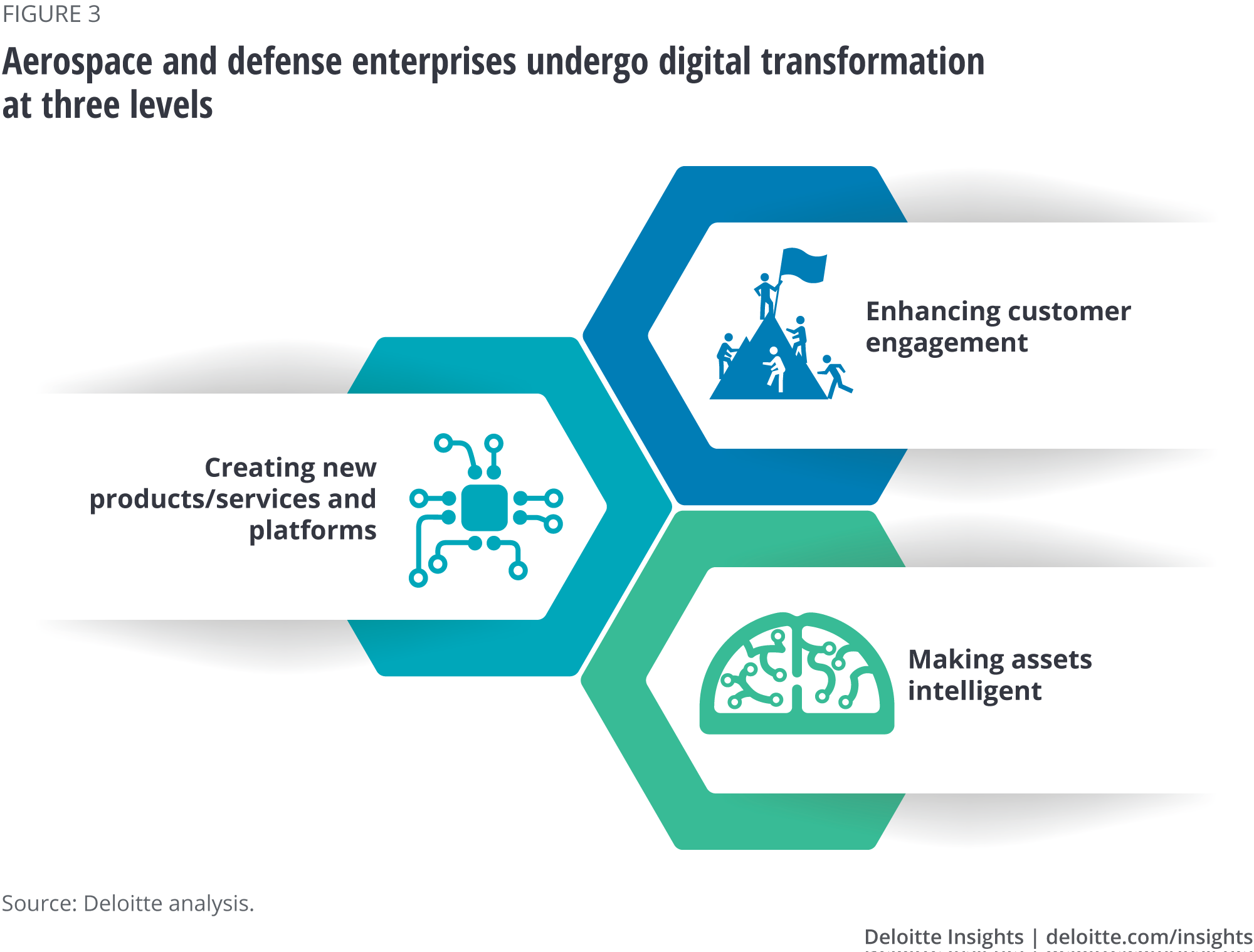
Aerospace & Defense 4.0 Capturing the value of Industry 4.0 technologies
9 minute read
12 February 2019
- Aijaz Hussain United States
 Tim Hanley United States
Tim Hanley United States Vincent Rutgers United States
Vincent Rutgers United States Brenna Sniderman United States
Brenna Sniderman United States
With some aerospace and defense organizations lagging in the adoption of Industry 4.0, what can A&D companies do better to achieve digital transformation?
Industry 4.0 technologies could be the key to unlocking future competitiveness. There is a clear and compelling case for aerospace and defense (A&D) companies to leverage these technologies and incorporate digital transformation throughout their organizations. In a global survey conducted by Deloitte to assess the current state of Industry 4.0 adoption across manufacturing industries, 84 percent of A&D executives said they consider leveraging new digital technologies as key to market differentiation—yet only a quarter of the A&D companies are currently using these technologies and tools to access, manage, analyze, and leverage data from their digital assets to inform decision-making in real time.1
Industry 4.0-driven technologies can impact every company that operates within the A&D industry, from original equipment manufacturers (OEMs) to small suppliers. However, not all companies seem to be taking advantage of these technologies, whether for growing revenues or improving profitability. Designing new products and business models remains a significant challenge for most A&D companies, with 40 percent of the surveyed A&D executives identifying the establishment of new business or delivery models as the top challenge their organization faces as they pursue digital transformation initiatives.2
Furthermore, despite implementing Industry 4.0 technologies in areas such as factory manufacturing and supply chain, many A&D companies have been slow in adopting broader digital transformation initiatives that span the entire enterprise.3 This is because many surveyed companies in the industry note that they have not made Industry 4.0 a priority across the enterprise; rather, they have primarily invested in specific, focused technology implementations. Limiting the digital strategy to a few business functions may increase the risk of A&D companies being left behind in today’s digital era. It is important, therefore, that companies across the industry understand and harness the power of new technologies to benefit from the opportunities of Industry 4.0 transformation. A&D companies, especially mid- and small-sized, could start small but scale enterprisewide to maximize the benefits of these technologies. Instead of viewing new technologies as an add-on to existing processes and practices, A&D executives should rethink how they do business leveraging those technologies. This report explores the lessons A&D companies appear to have learned in their journey in becoming digitally transformed enterprises and recommends how they could thrive in this age of Industry 4.0.
Key takeaways
- A&D executives face many challenges while pursuing digital transformation initiatives.
- Designing new products and business models remains the top challenge.
- The pace of technological change and a lack of technology know-how are the key technological and strategic barriers.
- Adoption of broad digital transformation initiatives that span the entire enterprise has been slow in many A&D organizations.
- As a result, only a small section of A&D companies seems to be truly benefiting from the opportunities provided by Industry 4.0 technologies.
What is Aerospace & Defense 4.0?
Aerospace & Defense 4.0 is the application of the Industry 4.0 technologies in the A&D industry for developing new cost-effective products and services, making existing products smarter using sensors and connectivity, and leveraging advanced manufacturing processes such as additive manufacturing, among other objectives.
What is Industry 4.0?
Industry 4.0, or the Fourth Industrial Revolution, is the creation of a digital manufacturing enterprise that is not only interconnected but also communicates, analyzes, and uses information to drive further intelligent action back in the physical world. It drives the physical act of designing, manufacturing, distribution, and performance in an ongoing cycle known as the physical-to-digital-to-physical (PDP) loop (figure 1).
Throughout this cycle, real-time access to data and intelligence is driven by the continuous and cyclical flow of information and actions between the physical and digital worlds. Many organizations already have some portions of the PDP loop in place, namely, the physical-to-digital and digital-to-digital processes. However, it is the leap from digital back to physical—from connected, digital technologies to action in the physical world—that constitutes the essence of Industry 4.0.

Some A&D companies are already beginning to realize the transformative effects of these technologies (figure 2). They are exploring significant potential value across a variety of dimensions, from cutting costs and restructuring supply chains to expediting time to delivery and making devices and products connected across the board.

For instance, real-time flight data collected from sensors in aircraft is being used to reduce fuel consumption, improve scheduling, and minimize flight delays.4 Aerospace & Defense 4.0 technologies are also improving the aftermarket experience by using data to track asset condition and predicting parts and systems failures beforehand.
Moving to a more transformational use of technology: Key focus areas of Aerospace & Defense 4.0
As the market impact of A&D 4.0 technologies plays out, barriers to entry are lowering and industry lines are blurring. Competition is emerging from new entrants into the market, who are moving beyond creating traditional physical products to using data gleaned from customers and product functioning to create new revenue streams. In the long run, players that are nimble and adept at leveraging multiple advanced technologies could scale up, outperform, and outcompete their industry counterparts. Our research suggests there are four key areas A&D companies should focus on to become digitally transformed enterprises:
Be agile. As A&D customers become more demanding in terms of delivery schedules and customization, companies are expected to increasingly need highly agile production and predictive quality controls that adapt to changes in demand. For instance, commercial aircraft backlog remained at an all-time high of about 14,700 units at the end of September 2018, representing around nine years of the current annual production rate and leading aircraft manufacturers to ramp up production in response to growing aircraft demand.5 Leveraging Industry 4.0, aircraft manufacturers could model components and test assembled systems without having to create physical prototypes, thereby shortening the time to discovery while accelerating the product development process. For example, as Airbus sought to develop an agile manufacturing process, the company joined Adaptive Ramp-Up Management, an EU research project focusing primarily on new product development in the aircraft and shipbuilding industries. As part of the project, Airbus conducted various simulation sessions for the A350 aircraft to ensure that the new design and advanced materials used in the aircraft would not result in unnecessary cost and schedule overruns. As a result, the development cost of the program came in at less than half of a comparable aircraft program of a competitor.6
Build new business models. The data that results from connected systems inherent in Industry 4.0 presents significant opportunities. And today's A&D products produce vast amounts of information from thousands of sensors and systems. As such, A&D companies should leverage this information not only for designing, manufacturing, and operating their products but also for developing new business models. The industry could leverage advanced analytics and predictive applications to optimize maintenance, repair, and overhaul processes, and leverage the increased access to performance data to create new services. For instance, Boeing recently launched AnalytX, through which it provides data analytics tools and services to its customers. The company’s analytics-based solutions and consulting services were designed to help customers enhance operations by exploring data-based flight plans that deliver insights to help maximize fuel efficiency and minimize operational disruptions.7 The AnalytX platform had more than 200 customers at the end of 2017, and Boeing expects further growth in its customer base, while aiming to ramp up its data-based services.8
Collaborate closely with supply chain. Unanticipated supply chain and vendor challenges, coupled with unpredictable program management issues, often pose another significant challenge. Owing to demands for increased capacity and on-time delivery, the A&D supply chain is currently being transformed,9 and A&D manufacturers should work closely with vendors to innovate, collaborate, and share best practices in digital manufacturing. A&D companies could achieve this using digital design, simulation, and integration, which can help them conceptualize and digitally construct a virtual prototype or a process. This could help enable digital integration across the manufacturing life cycle and increase supply chain visibility. Furthermore, the industry can use high-performance or quantum computing to enable intelligent supply chains that model and simulate manufacturing processes to fix errors as well as analyze inventory to optimize logistics. To enhance collaboration, Dassault Systèmes developed AirDesign under the governance of BoostAeroSpace—a private cloud created by European A&D manufacturers. AirDesign provides a platform for collaborative innovation between A&D industry players—from OEMs to small and medium suppliers.10
Adapt to the new cybersecurity paradigm. With the adoption of connected systems and the proliferation of data, A&D companies face increased cybersecurity risks. In fact, various A&D executives surveyed quoted cyber risks and data ownership to be the most common technological challenges their organizations face as they seek to pursue their digital transformation initiatives.11 A&D companies are highly security-conscious and focus on managing inherent vulnerabilities that come with increased digitization. They are keenly aware of the various national and global regulations around cybersecurity, such as compliance with National Institute of Standards and Technology’s cybersecurity guidelines in the United States.12 In an era of digitization where cyberthreats continue to rise, some defense contractors are already focusing more on ensuring safety of data and intellectual property from cybersecurity risks. For example, in an effort to protect its global networks and intellectual property, Northrop Grumman has set up a dedicated cyber security operations center (CSOC), the purpose of which is intelligence collection, threat detection, incident response, digital forensics, and continuous security monitoring to detect and avoid cyberattacks.13
Navigating the path to Industry 4.0 success
The impact Industry 4.0 technologies can have on A&D companies varies depending on a company’s size, where it is in the supply chain, what its role in the supply chain is, and, most importantly, its business focus. For A&D companies to successfully implement Industry 4.0 at the enterprise level, digital transformation should occur at three levels: customer engagement, new products/services and platforms, and intelligent assets (figure 3).

Enhancing customer engagement. A&D companies should leverage Industry 4.0 technologies to create a differentiated customer experience and foster a customer-centric culture through service excellence and customer engagement. By utilizing advanced technologies, A&D companies may unlock new customer insights and improve customer engagement while monitoring evolving customer needs, preferences, and shifts in demand. For example, Raytheon is focusing on delivering improved customer satisfaction using process architecture built upon systems that include product data management, manufacturing systems, and supplier assessment tools—all connected to front- and back-end metrics. The company is enhancing these core systems with digital capabilities such as big data management, virtual reality, and predictive analytics. Moreover, its Immersive Design Center leverages a 3D immersive environment to facilitate codevelopment and coproduction of products and better align customers. By integrating digital technologies, Raytheon plans to help customers test designs and enable them to provide feedback in the initial phase, enhancing customer engagement and reducing the possibility of cost and schedule overruns.14
Creating new products/services and platforms. Product or service innovation in the A&D industry can be a drawn-out and difficult process; R&D for new products can take several years, with another few years spent in commercializing them. Digital technologies can open new opportunities for innovation for the A&D industry by not only reducing the time to design, develop, and commercialize new products, but also by providing insights and ideas from different stakeholders that feed back into the development cycle. A case in point is Thales Digital Factory, which is developing innovative products based on key digital technologies such as big data, artificial intelligence, and the Internet of Things (IoT). Acting as a startup ecosystem, Thales is developing new ideas as “minimum viable products (MVP),” helping accelerate the pace at which these ideas become reality to get the product to market faster, better, and cheaper. Through a combination of digital skills and engineering excellence, Thales is working toward a successful digital transformation across its global businesses.15
Making assets intelligent. Using Industry 4.0 technologies to make assets smarter and more self-aware can help A&D companies improve utilization and efficiency. For example, digital twin technology makes it possible to virtually see inside a jet engine or even an entire aircraft located anywhere, to better understand how an IoT-connected engine operates and interacts within its environment. The benefits of this visibility range from optimizing the engine design to monitoring its performance to predicting maintenance needs, ultimately improving the overall experience and value for customers. Lockheed Martin is using data from connected systems to create, innovate, and replicate components, products, and entire programs as part of a totally integrated system where data threads come together to form a “Digital Tapestry,” which brings people, processes, and tools into a common information framework across the life cycle of its products. This free flow of digital information eliminates the manual transfer of data and the costly errors that go with it. With Digital Tapestry, Lockheed's designs can be printed, and form, fit, and function can all be checked before manufacturing, helping lower the costs.16
A holistic path to digital transformation
Although A&D organizations are leveraging Industry 4.0 technologies, the opportunity exists to implement this more broadly across the enterprise, by focusing on four key areas: becoming agile, building new business models, ensuring close collaboration with the supply chain, and safeguarding data and intellectual property from cybersecurity risks. While there could be many potential pathways to becoming a digitally transformed enterprise, an industry player that leverages intelligent assets to create new products/services and platforms and increase customer engagement can be highly successful.
Industry executives should think of Aerospace & Defense 4.0 as an enterprisewide investment into driving long-term growth, innovation, productivity, and efficiency. Their approach should be holistic rather than focusing on small random acts of digital. Moreover, since these technologies could be much more sustainable and robust over business cycles, A&D executives should align top leadership, talent, and investments around digital transformation. Being able to completely leverage innovative, game-changing technologies could be a matter of survival in the increasingly “disrupt or be disrupted” A&D industry.
More insights from Aerospace & Defense
-
Business model compatibility in A&D deals Article6 years ago
-
Industry 4.0 in government Article7 years ago
-
3D opportunity for aerospace and defense Article10 years ago
-
Military readiness Article6 years ago
-
Innovation in the Military Health System Article6 years ago













